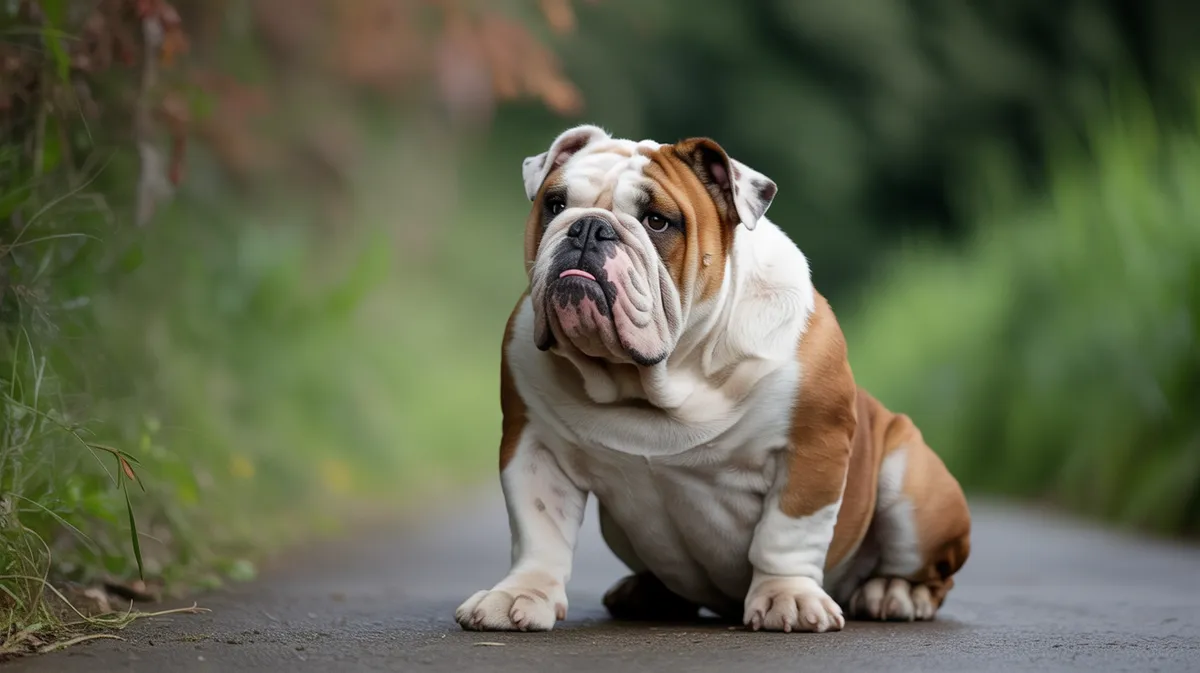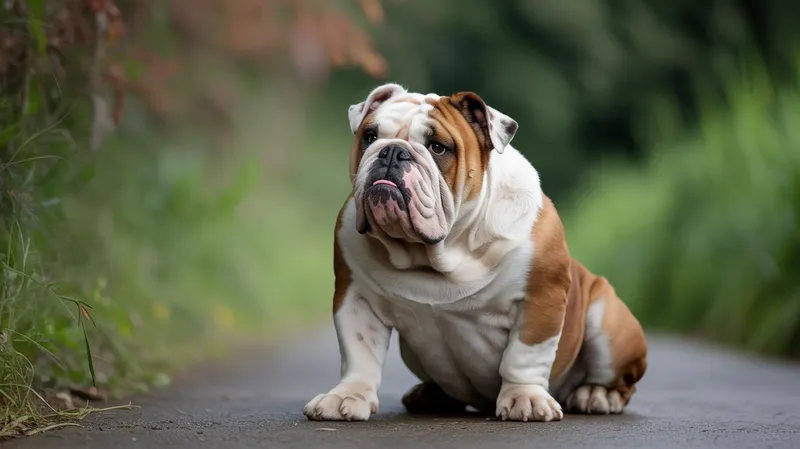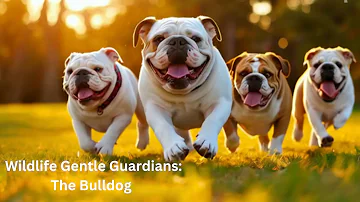
Bulldog
Canis lupus familiaris

Meet the Bulldog
The Bulldog is a medium-sized, muscular breed of domestic dog known for its characteristic loose, wrinkled skin, short snout, and distinctive pushed-in face. Originally bred in England for bull-baiting, Bulldogs are now cherished as affectionate and loyal companion animals. They have a calm, courageous temperament and are particularly noted for their gentle disposition with children. Despite their tough appearance, Bulldogs require special care due to their unique physical structure, especially regarding breathing and overheating.
Classification
Mammal
Habitat
Domestic (human households, urban environments)
Diet
Omnivore
Lifespan
8-10 years
Conservation
Least Concern
Weight
18-23 kg (40-50 lbs)
📖Fascinating Facts
Gentle Companions
Despite their history as bull-baiters, modern Bulldogs are known for being gentle, affectionate, and excellent with children.
Heavy Snorers
Their short snouts cause Bulldogs to snore loudly and make a range of unique noises while breathing and sleeping.
Not Natural Swimmers
Due to their body structure, Bulldogs typically cannot swim and should be closely supervised around water.
📋Detailed Description
The Bulldog (Canis lupus familiaris), also known as the English or British Bulldog, is a medium-sized, compact dog breed characterized by a broad, muscular body, short limbs, and a distinctive brachycephalic (short-muzzled) skull. Adult males typically weigh around 25 kg (55 lbs), while females average 23 kg (50 lbs). The breed's hallmark features include pronounced skin folds on the face and neck, a wide, undershot jaw, and a short, smooth coat that comes in a variety of colors such as brindle, white, red, fawn, yellow, or piebald. Bulldogs have a relatively short tail, often naturally straight or screwed. Their anatomy, especially the flattened face and narrow nostrils, predisposes them to respiratory challenges. Despite their formidable appearance, Bulldogs are known for their gentle, affectionate temperament and strong attachment to their human families. They are generally low-energy, preferring short walks and long periods of rest, and are highly tolerant of children and other pets. Bulldogs are not well-suited to rigorous exercise or hot climates due to their compromised thermoregulation. The breed's reproductive anatomy often necessitates veterinary assistance for mating and delivery, with many litters born via cesarean section. Lifespan averages 8–10 years, with health and longevity closely tied to responsible breeding and veterinary care.
💡 Did you know?
The Bulldog's unique appearance is the result of selective breeding, but this also makes them prone to certain health issues, especially respiratory problems.
🔬Research & Sources
Wikipedia Summary
The Bulldog is a British breed of dog of mastiff type. It may also be known as the English Bulldog or British Bulldog. It is a stocky, muscular dog of medium size, with a large head, thick folds of skin around the face and shoulders and a relatively flat face with a protruding lower jaw. Selective breeding for appearance has led to increased susceptibility to health problems including brachycephaly, hip dysplasia, heat sensitivity and skin infections. The dogs may not be bred in Norway or the Netherlands, because of concerns about their quality of life.
Last Modified: 5/30/2025
🎭Behavior & Social Structure
Bulldogs are renowned for their calm, even-tempered disposition and strong loyalty to their owners. They are typically non-aggressive, displaying patience and gentleness, especially with children. Bulldogs are not highly active; they enjoy short walks and moderate play but are prone to lethargy and can be stubborn when motivated. Their feeding behavior is omnivorous, though they require a balanced, calorie-controlled diet to prevent obesity—a common health concern. Bulldogs are social animals, forming close bonds with family members and often seeking physical closeness. They are not natural hunters and exhibit little prey drive compared to other breeds. Daily routines usually involve periods of rest interspersed with brief activity, and they may be prone to snoring and drooling due to their facial structure. Bulldogs are generally tolerant of other dogs and pets, though early socialization is recommended to reinforce positive interactions.
👶Reproduction & Life Cycle
Bulldog reproduction is notably challenging due to the breed's physical conformation. Natural mating is often difficult because of the male's broad chest and the female's narrow hips, leading to a high reliance on artificial insemination. The gestation period is typical for domestic dogs, averaging 63 days. Due to the puppies' large heads relative to the dam's pelvic width, over 80% of Bulldog litters are delivered via cesarean section to prevent dystocia (obstructed labor). Litter sizes typically range from 4 to 5 puppies. Parental care is largely provided by humans, as mothers may have difficulty nursing and caring for their young due to their anatomy and potential respiratory distress. Breeding is carefully managed to minimize inherited health issues, with reputable breeders screening for genetic diseases and prioritizing the welfare of both dam and puppies.
🛡️Adaptations & Survival
The Bulldog's most distinctive adaptations are the result of intense selective breeding for specific physical traits. The brachycephalic skull and undershot jaw were originally developed to aid in gripping during bull-baiting, though these features now primarily serve as breed identifiers. The loose, thick skin around the head and neck provided some protection during fights. Modern Bulldogs have adapted to a companion lifestyle, exhibiting low activity levels and a docile temperament, which suits urban living. However, these physical adaptations come at a cost: the breed is prone to brachycephalic obstructive airway syndrome (BOAS), heat intolerance, and joint issues such as hip dysplasia. Their short, smooth coat offers little protection against extreme temperatures, necessitating an indoor lifestyle.
📚Research Sources
🎨Cultural Significance
The Bulldog is an enduring symbol of British tenacity, resilience, and determination, famously associated with Winston Churchill and the 'British Bulldog spirit' during World War II. The breed is a popular mascot for sports teams, military units, and organizations worldwide, representing courage and steadfastness. Bulldogs have appeared in art, literature, and media, often embodying loyalty and strength. While no longer used for bull-baiting, their modern role is that of a cherished companion and family pet. The breed's iconic appearance and temperament have made it a fixture in popular culture, though this fame has also contributed to overbreeding and associated health issues.
🔬Recent Research & Discoveries
Recent scientific research has focused on the genetic basis of brachycephaly and its health implications, with studies identifying mutations affecting skull morphology and airway function. Veterinary research has highlighted the prevalence of BOAS and the need for revised breed standards to prioritize health over appearance. Ongoing studies are investigating the efficacy of surgical interventions for airway obstruction and the impact of selective breeding on genetic diversity. Welfare organizations and veterinary associations advocate for responsible breeding practices, including outcrossing to improve health outcomes. The Bulldog serves as a model for understanding the consequences of extreme selective breeding in domestic animals.
🎥Wildlife Videos

Wildlife Gentle Guardians: The Bulldog | Animated | Informative #wildlife#wild#documentary
Wildlife Gentle Guardians: The Bulldog | Animated | Informative |Nature ...
Animals World.official

Wildlife - The Fascinating World of Wild Animals | Full Series | Free Documentary Nature
Wildlife - The Fascinating World of Wild Animals | Wildlife Documentary Watch 'Ocean Stories - Full Series' here: ...
Free Documentary - Nature

Wild Canada - Nature's Untamed Beauty | Full Series | Free Documentary Nature
Wild Canada - Nature's Untamed Beauty | Wildlife Documentary Watch 'Darkwoods - Canada's Hidden Nature Reserve' here: ...
Free Documentary - Nature

3 Hours of The Untold Stories of British Wildlife | Our World
A wildlife documentary series, narrated by Hugh Bonneville, uncovering the hidden lives of animals across diverse habitats ...
Our World

Our Planet | From Deserts to Grasslands | FULL EPISODE | Netflix
Experience our planet's natural beauty and examine how climate change impacts all living creatures in this ambitious ...
Netflix

THE SWISS ALPS | Secrets of the Apex Hunters | Animal documentary
Welcome to the majestic Swiss Alps, a breathtaking wilderness that's home to some of the most extraordinary apex predators on ...
WILD NATURE - Nature animal documentary
🌍Habitat Information
The Bulldog typically inhabits Domestic (human households, urban environments) environments. Bulldogs have adapted to their environments with specialized features and behaviors.
Primary Habitat:
Domestic (human households, urban environments)
More detailed habitat information will be available soon.
🛡️Conservation Status
The Bulldog is currently classified as Least Concern. Conservation efforts are crucial for preserving this species for future generations.
Common Threats:
- 🏠Habitat loss and fragmentation
- 🌡️Climate change impacts
- 🎯Hunting and poaching
- 🏭Human-wildlife conflict
⚠️Threats & Conservation Challenges
The Bulldog faces significant health and welfare challenges due to its exaggerated physical traits. Brachycephaly leads to chronic respiratory distress, exercise intolerance, and increased risk of heatstroke. Orthopedic problems, such as hip and elbow dysplasia, are common, as are skin infections in the facial folds (pyoderma) and ocular disorders like cherry eye. Obesity is a prevalent issue, exacerbating existing health problems. These concerns have led to legislative action in some countries: Norway and the Netherlands have restricted or banned Bulldog breeding on animal welfare grounds. Population trends remain stable due to the breed's popularity, but ethical breeding practices and genetic diversity are ongoing concerns for long-term viability.
🔬Scientific Classification
Scientific Name
Canis lupus familiaris
Classification Hierarchy
🔍 About Taxonomic Classification
Taxonomic classification is a hierarchical system used by scientists to classify and organize living organisms based on shared characteristics and evolutionary relationships.
The system moves from broad categories (Kingdom) to increasingly specific ones, with each animal's scientific name typically consisting of its Genus and species.
📝Community Notes
Share your observations and insights about the Bulldog with our community of wildlife enthusiasts.
Join Our Community
Sign in to share your observations and connect with fellow wildlife enthusiasts.
Sign In to ContributeNo community notes yet
Be the first to share your observations about the Bulldog!
Explore Bulldog
Select a tab above to learn more about this amazing animal.
📸Photo Gallery
No photos available for this animal yet.
🌟Discover More Wildlife
Continue your journey of discovery with more fascinating animals from our database
